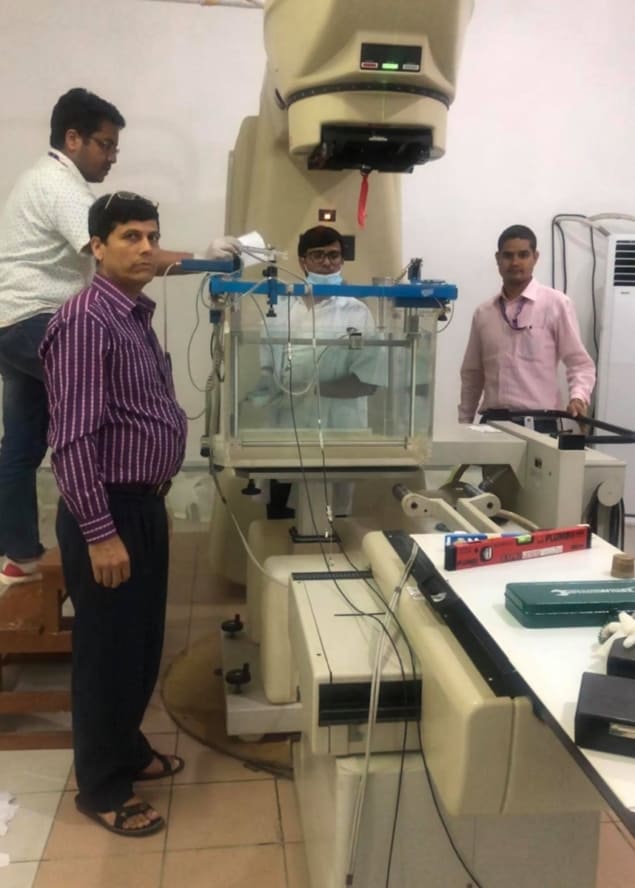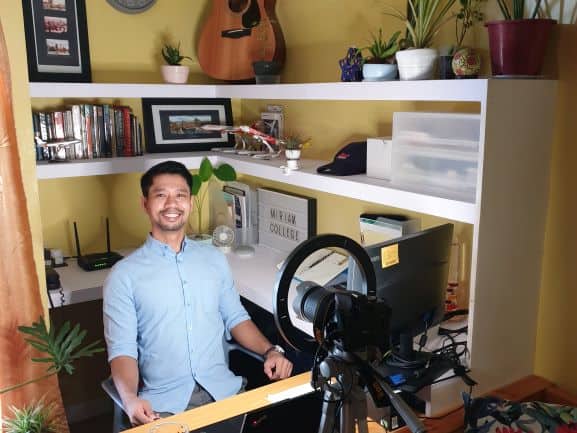Tirthraj Adhikari is a radiation oncology physicist at the BP Koirala Memorial Cancer Hospital in Nepal.
This post is part of a series on how the COVID-19 pandemic is affecting the personal and professional lives of physicists around the world. If you’d like to share your own perspective, please contact us at pwld@ioppublishing.org.

I started work at the BP Koirala Memorial Cancer Hospital in Nepal at the beginning of this year as a fresh radiation oncology physicist. I had left Italy after graduating from the ICTP, just a month before the start of the COVID-19 pandemic. I was the first clinical physicist to be given an appointment from the Ministry of Health & Population to work as a clinical medical physicist in Nepal.
January 17th was my first day in the radiation oncology department, which has seven physicians and four physicists. The hospital has three linacs, a simulator and a brachytherapy system for intracavitary treatment. It is the one of the busiest cancer centres in Nepal, with cancer patients visiting from all over the country. I interacted with patients from remote parts of Nepal, some of whom have to travel 16 to 20 hours by bus, after having trekked for one or two days. I was eager to chat with them, as I myself come from a remote village in far-West Nepal. For patients from my region, it takes on average 18 hours by bus to reach the cancer hospital.
During treatments, I noticed that – due to a lack of screening and diagnosis – patients would visit the hospital in the late stages of their disease. The major factor is poverty. When someone in a remote village feels sick, they usually visit the pharmacy and buy medicine without prescriptions from physicians. This makes them feel well for some time, but after a while the problems return. After several such attempts, the patient becomes serious and decides to visit the hospital. Unfortunately, by this time the cancer has reached a late stage and treatment becomes difficult.
The patient may have to undergo major surgery, but they cannot afford the cost. If they manage to afford surgery, they cannot afford radiotherapy, which is expensive. It is sad that for many patients who need treatment with a complex radiotherapy technique, we have to shift to a simple technique just because of the cost. For example, one patient with head-and-neck cancer was a candidate for volumetric-modulated arc therapy (VMAT), but we treated him using cobalt-60 radiotherapy because it is relatively inexpensive.
During this period, I created treatment plans for about 230 patients. Most of these were cobalt-60, 2D and 3D conformal radiotherapy (CRT) plans for head-and-neck, cervix and breast cancers. In addition, I created a few intensity-modulated radiotherapy (IMRT) and VMAT treatment plans for prostate and oesophagus cancers, and brachytherapy plans for cervical cancer. I remember that I created more plans for palliative than curative cases.
In addition to the treatment planning, I was involved in quality assurance and quality control in the department. Every day, I’d commute to the hospital early in the morning, do the daily quality assurance of the linacs, and make the CT simulator and brachytherapy machine ready for treatment and simulation. At our department, frequent problems with the machines arise during treatment delivery. I was engaged in troubleshooting of the linacs and CT simulator with senior physicists in the department.
The impact of COVID-19
The first COVID-19 patient in Nepal was identified in early February. He had flown from Wuhan in China to Nepal, and he soon recovered. Then the government declared us a corona-free state, while cases were growing in China, Italy and then the USA. However, in March, a girl who fled from Qatar was diagnosed with COVID-19 infection and cases grew over time. The government then imposed a lockdown to prevent transmission to the community. This harshly affected all patients, including cancer patients.
As we did not have personal protective equipment (PPE) in our department, the hospital stopped treatments for three days the first time. Treatments soon resumed, but some patients had already left the hospital, as there was uncertainty when treatments would restart and difficulties with accommodation. Those patients who were living in the hospital wards and in the hospital periphery received the remaining fractions of their radiation treatments. But some patients had already travelled more than 600 km to their home.
Under normal conditions, the department used to treat 180 to 200 patients per day. But with lockdown, the number of patients declined rapidly, to 30 to 40 patients per day. This happened firstly because it was difficult for patients to travel the hospital – the lockdown meant there was no public transport and travel by ambulances was not affordable. Secondly, hospital personnel were afraid to touch or take care of patients without having PPE. During the first period of prolonged lockdown, around 30 patients who were having radiotherapy died at their homes.
After four months of lockdown, the hospital resumed normal activity and our department started to treat normally again. Patients who survived the lockdown came back to the hospital for their remaining treatments. For us, it was difficult to decide whether to treat patients with plans created four months earlier. Some patients had re-simulation after changes in their diagnosis and plans were recreated for them. For those who had already received some radiation fractions, the gap was calculated and dose was managed accordingly.
Following a spike in COVID-19 infected patients, the government imposed a second lockdown from the middle of August. At the time, some hospital personnel were also infected, though fortunately none of our department. Treatment was stopped, again for some days, with the same problems — it was a high risk for us to treat patients without proper PPE and testing. We demanded mandatory PCR tests for patients and their visitors to keep ourselves safe. Then the treatment resumed, but with fewer patients than under normal conditions.
A patient from Bardiya, a district of West Nepal, had started treatment in February. His head-and-neck cancer was being treated by 3D CRT. With three fractions remaining, his treatment was impeded because of the pandemic, and he was not able to resume treatment due to the ongoing pandemic. He contacted me recently saying that he had difficulty in breathing. I suggested that he visit the department soon for follow-up. But in the meantime, the government had imposed the second lockdown. I am wondering how he will manage to travel 600 km. The cancer patients in Nepal have been affected miserably by this COVID-19 pandemic.
Time management
This pandemic has adversely affected everyone’s lives. To keep myself physically active, I do regular yoga in the morning, wearing a mask, and I walk in the evening, maintaining physical distance.
In addition to the usual departmental clinical tasks, I used to talk with seniors, physicians and technicians about treatments, innovations, politics and science-economics. During lockdown, I followed more than 80 national and international webinars. In addition, I composed articles in my native language about nuclear laws in Nepal, radiation protection, cancer radiotherapy, managing errors in radiation therapy, the importance of radiation dosimetry in cancer care, and the increasing needs of the public cancer hospital in Nepal. I also prepared a proposal to establish a cancer hospital in my region, where there is no cancer centre and people have to travel at least 16 hours to the nearest cancer hospital.
To engage myself, I have taken 25 online/remote training courses during this pandemic, covering themes including radiation protection, nuclear safety, radiotherapy safety, image-guided radiation therapy and stereotactic radiosurgery. More importantly, to stay updated, keep myself safe from COVID-19 infection and answer people’s questions, I took 10 online training courses from the World Health Organization. With this training, I gained confidence in how to deal with COVID-19.

Physics in the pandemic: ‘I took it upon myself to keep my classes alive, even if lessons had to be conducted via Zoom’
Finally, I attended the 2020 AAPM|COMP Virtual Meeting. It was possible to attend this conference as a friend of mine from the USA paid the registration fee for me. Because of the time difference between Nepal and the USA, I stayed up the whole night to follow the presentations.
Being a fresher, I have never felt nervous in dealing with radiation treatment during the pandemic, despite the risks. We continue to treat cancer patients with limited protective resources from COVID-19. But because of pandemic, I have had plenty of time to learn and implement ideas and techniques that I learnt while abroad. I personally took this pandemic as an opportunity — keeping myself busy by learning and teaching others remotely. Nobody knows what will happen tomorrow, so keeping yourself ready to face any unpredicted situation is wise.
